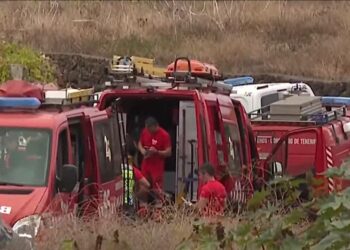The president of the Tenerife Island Council, Rosa Dávila, announced a significant milestone in the Southern Train project yesterday, following the awarding of the contract for the second revision of the environmental impact study. According to Dávila, this advancement will help revitalise a crucial infrastructure aimed at alleviating road traffic and decreasing CO2 emissions. “More than 125,000 vehicles travel daily through the South,” she noted.
As per the president, the primary focus of this section, which will link Costa Adeje with San Isidro (Granadilla), is expected to cut down up to half a million car journeys each day, aiding in the reduction of congestion on the TF-1, which is one of the island’s most heavily trafficked routes. She added that construction could commence “within this mandate and will take approximately four years,” suggesting that this initial leg of the train could be operational by the year 2031 at the latest, according to estimates from the Island Corporation. Dávila emphasised the significance of this update, which has a budget of 68,500 euros and an execution timeframe of eight months, viewing it as a “starting point with no turning back” in the project’s advancement. “With this report, we are now at the kickoff for the development of the railway line, projected to cost over 800 million euros,” remarked the president, further underscoring that this section could facilitate a reduction of half a million daily car trips.
The Cabildo has projected that the train will have the capacity to transport more than 20 million passengers each year, positioning it as the second busiest railway system in Spain, only behind the Madrid suburban line. This segment is designed to connect vital areas for the island’s mobility and economy, including the industrial zone of Las Chafiras, Tenerife South airport, the port of Los Cristianos, and El Mojón hospital. The south is grappling with a mobility crisis that has persisted for years, a concern highlighted by José Miguel Rodríguez Fraga, mayor of Adeje: “The major mobility issue in the south remains unresolved, and it is evident that no single solution exists; it requires the integration of various projects.”
Fraga voiced doubts about the train being a quick fix, emphasising the urgency of addressing other priorities first, such as the addition of a third lane to the TF-1, the underground construction of certain motorway sections, or the completion of the island’s ring road. Granadilla de Abona’s mayor, Jennifer Miranda, expressed her discontent with the current mobility scenario in southern Tenerife, pointing out that while an 800 million euro infrastructure is being proposed with hopes of it becoming operational by 2031, “thousands of Tenerife residents continue to endure endless traffic every day.” She also highlighted that the issue impacts not only automobiles on the motorway but also commuters who spend “hours and hours” waiting at bus stops, like those in San Isidro, because of the insufficient number of lines available. “The citizens of southern Tenerife are weary of the same old promises,” she concluded. In contrast, Arona’s mayor, Fátima Lemes, was more reserved in her comments, stating that “it is essential to await the findings of the updated environmental impact study to evaluate the project.” Nonetheless, she acknowledged the severity of the mobility challenges in the south, where tourist traffic, the job market, and the port of Los Cristianos converge. “It could serve as a potential solution to enhance daily transport from other areas of the island,” she noted.
“Stalled infrastructure”
The president remarked that this strategic infrastructure had been stalled since 2019 due to a lack of progress and the expiration of the initial environmental impact study. “We have wasted some extremely valuable years. The need to revise the environmental impact report is a direct result of this,” she lamented. However, Dávila remained optimistic, assuring that her team is dedicated to expediting the processes necessary for “the train to become a reality as swiftly as possible.” She also indicated that the project will be implemented in phases and has the backing of both the Canary Islands Government and the Spanish Government, aiming to include it in the State Railway Network of General Interest, which would facilitate access to European funding.
















